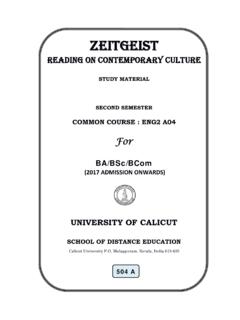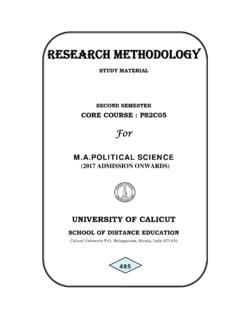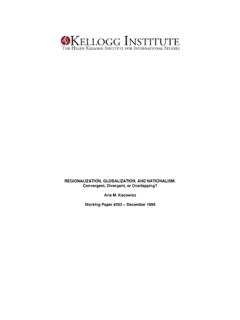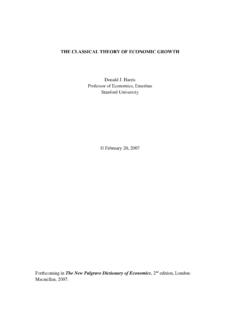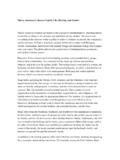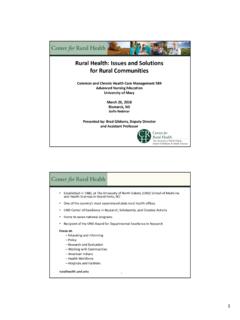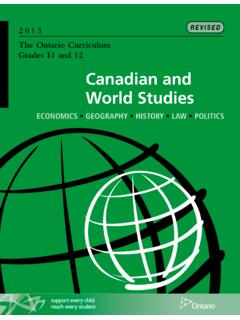Transcription of MATHEMATICAL ECONOMICS
1 MATHEMATICALECONOMICSSTUDY MATERIALVI SEMESTERCORE COURSE:ECO6 (2014 Admission onwards)UNIVERSITY OF CALICUTSCHOOL OF DISTANCE EDUCATIONC alicut University Malappuram, Kerala, India 673 635712 School of Distance EducationMathematical EconomicsPage2 UNIVERSITY OF CALICUTSCHOOL OF DISTANCE EDUCATIONSTUDY (2014 Admission onwards)CORE COURSE:ECO6 B12:MathematicalEconomicsPrepared by:ModulesI& II:Dr. Chacko Jose PAssociate professorDepartment of EconomicsSacred Heart CollegeChalakudyThrissur 680307 Module III& V:Fathimath Sajna,Research Assistant,KSHEC Research Project,Govt. College KodancheryModule IV:Rajimol. ,HoD of ECONOMICS ,NMSM Govt.
2 College, KalpattaEditor:Dr. C. KrishnanPrincipal,Government College Kodanchery,Kozhikode 673 Computer Section, SDE ReservedSchool of Distance EducationMathematical EconomicsPage3 CONTENTSPAGE IIntroduction to MATHEMATICAL ECONOMICS -5 Module IIMarginal Concepts-15 Module IIIO ptimisation-26 Module IVProduction Function,Linear ProgrammingAnd Input Output Analysis-32 Module VMarket Equilibrium-56 Syllabus-67 School of Distance EducationMathematical EconomicsPage4 School of Distance EducationMathematical EconomicsPage5 MODULE 1 INTRODUCTION TO MATHEMATICAL ECONOMICSM athematical ECONOMICS :Meaningand Importance,MathematicalRepresentation ofEconomic Models, Economicfunctions: Demand function, Supply function, Utility function,Consumption function, Production function, Cost function, Revenue function, Profit function,Saving function, Investment MATHEMATICALECONOMICSM athematical ECONOMICS is a branch of ECONOMICS that engages MATHEMATICAL tools andmethods to analyse economic theories.
3 MATHEMATICAL ECONOMICS is best defined as a sub-fieldof ECONOMICS that examines the MATHEMATICAL aspects of economies and economic theories. Orput into other words, mathematics such as calculus, matrix algebra, and differential equationsare applied to illustrate economic theories and analyse economic may be interesting to begin the study of MATHEMATICAL ECONOMICS with an enquiry intothe history of MATHEMATICAL ECONOMICS . It is generally believed that the use of mathematics as atool of ECONOMICS dates from the pioneering work of Cournot (1838). However there weremany others who used mathematics in the analysis of economic ideas before Cournot.
4 We shallmake a quick survey of the most important William Petty is often regarded as the first economic statistician. In his Discourses onPolitical Arithmetic (1690), he declared that he wanted to reduce political and economicmatters to terms of number, weight, and first person to apply mathematics toeconomics with any success was an Italian, Giovanni Ceva who in 1711 wrote a tract in whichmathematical formulas were generously used. He is generally regarded as the first knownwriter to apply MATHEMATICAL method to economic Swiss mathematician DanielBernoulli in 1738 for the first time used calculus in his analysis of a probability that wouldresult from games of chance rather than from economic the early French writers who made some use of mathematics was Francois deForbonnais who used MATHEMATICAL symbols, especially for explaining the rate of exchangebetween two countries and how an equilibrium isfinally established between them.
5 He is bestknown for his severe attack this is a long list to those who showed curiosity in the use of mathematics ineconomics, interestingly J. B. Say showed little or no interest in the use of mathematics. He didnotfavourthe use of mathematics for explaining economic who isreasonably well known, especially in location theory, is Johann Heinrich von Thunen. His firstwork, The Isolated State (1826), was an attempt to explain how transportation costs influencethe location of agriculture and even the methods of French engineer, A. J. E. Dupuit, used MATHEMATICAL symbols to express his concepts ofsupply and demand.
6 Even though he had no systematic theory he did develop the concepts ofutility and diminishing utility, which were clearly stated andpresented in graphical of Distance EducationMathematical EconomicsPage6He viewed the price of a good as dependent on the price of other Lausanneeconomist, Vilfredo Pareto, ranks with the best in MATHEMATICAL virtuosity. The Pareto optimumand the indifference curve analysis (along with Edgeworth in England) were clearly conceivedin the MATHEMATICAL frame much more profound understanding of the analytical power of mathematics was shown byLeon Walras. He is generally regarded as the founder of the MATHEMATICAL school of set out to translate pure theory into pure the pioneering work of Jevons(1871) and Walras (1874), the use of mathematics in ECONOMICS progressed at very slow pacefor a number of years.
7 The first of thelattergroup is Edgeworth. His contribution tomathematical ECONOMICS is found mainly in the 1881 publication in which he dealt with thetheory of probability and statistical Y. Edgeworth s contribution to MATHEMATICAL ECONOMICS is found mainly in the 1881publication in which he dealt with the theory of probability, statistical theory and the law oferror. The indifference analysis was first propounded by Edgeworth in 1881 and restated in1906 by Pareto and in 1915 by the Russian economist Slutsky, who usedelaboratemathematical treatment of the Marshall made extensive use of mathematics in hisPrinciples of ECONOMICS (1890).
8 His interest in mathematics dates from his early schooldayswhen his first love was for mathematics, not the classics. In the Principles he usedmathematical techniques very economist whose influence spans many years is the American, Irving Fisher. Fisherbelongs to other groups as well as to the MATHEMATICAL moderns. His life's work reveals himasa statistician, econometrician, mathematician, pure theorist, teacher, social crusader, inventor,businessman, and scientist. His contribution to statistical method, The Making of IndexNumbers, was great. The well-known Fisher formula, M V + M' V' = PT, is an evidence of hiscontribution to quantitative strong inducement to formulate economic models in MATHEMATICAL terms has been thepost-World War II development of the electronic computer.
9 In the broad area of economicsthere has been a remarkable use of MATHEMATICAL techniques. ECONOMICS , like several otherdisciplines, has always used quantification to some degree. Common terms such as wealth,income, margins, factor returns, diminishing returns, trade balances, balance of payments, andthe many other familiar concepts have a quantitative connotation. All economic data have insome fashion been reduced to numbers which became generally known as economic most noteworthy developments, however, have come in the decades since about was approximately this time that marked the ebb of neoclassicism, the rise ofinstitutionalism, and the introduction of aggregate ECONOMICS .
10 Over a period of years scholarshave developed new techniques designed to help in the explanation of economic behaviorunder different market situations using mathematics. Now we discuss some of the economictheories and the techniques of modern analysis. They are given largely ona chronologicalbasis, and their significance is developed in the Theory of Games: The pioneering work was done by John von Neumann in 1928. Thetheory became popular with the publication of Theory of Games and , The Game Theory holds that the actions of players in gambling games areSchool of Distance EducationMathematical EconomicsPage7similar to situations that prevail in economic , political, and social life.

